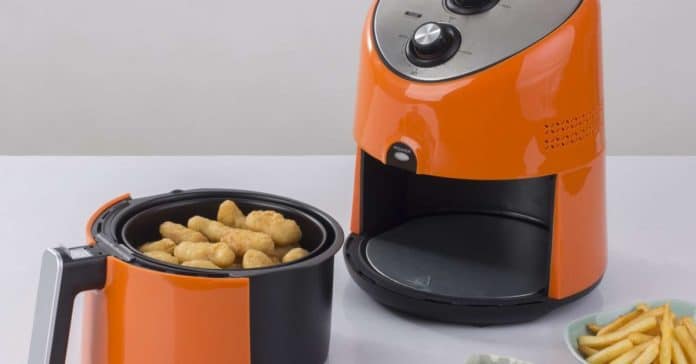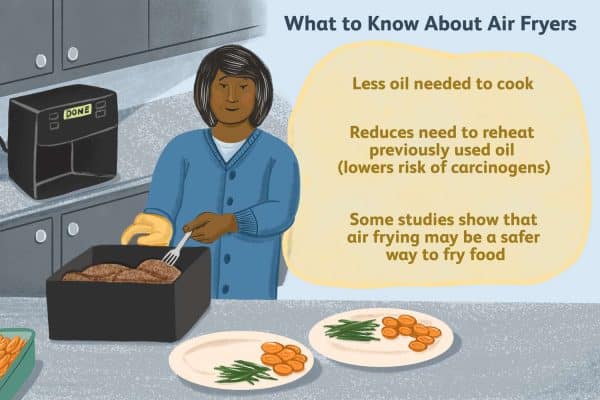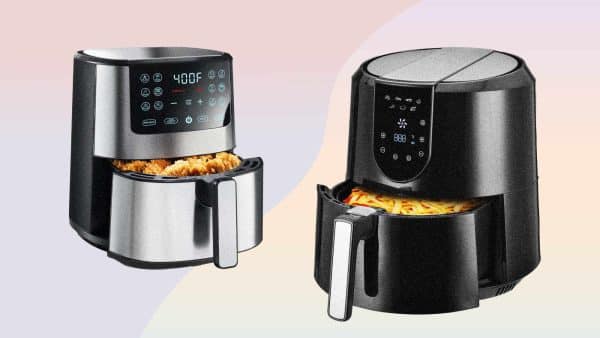Air fryers have become a popular kitchen appliance for those seeking a healthier alternative to traditional frying methods.
However, as the buzz around air fryers continues to grow, a question lingers in the minds of many: Are air fryers bad for the air in your home?
In this article, we will explore the potential impact of air fryers on the air quality within your living space, shedding light on the science behind these devices and providing practical tips to ensure a clean and healthy environment in your home.
So, let’s address the concerns and find out if your beloved air fryer is genuinely a friend or foe to the air you breathe.
1. How Do Air Fryers Work?
Air fryers have become increasingly popular as a healthier alternative to deep frying in recent years. But how exactly do they work? Let’s delve into the inner workings of these innovative kitchen appliances.
1.1 Convection Heating
One of the critical components of an air fryer is its convection heating system. Like a traditional oven, air fryers use a heating element to produce hot air. This hot air is then distributed evenly around the food by a powerful fan, creating heat circulation.
1.2 Rapid Air Technology
The rapid air technology employed by air fryers sets them apart from other cooking methods. Convection heating with high-speed air circulation allows air fryers to cook food quickly and evenly. The hot air rapidly surrounds the food, ensuring a crispy exterior while locking in moisture for a tender interior.
1.3 Cooking Process
When you place food in an air fryer, the circulating hot air cooks it from all angles. The dry heat produced by the air fryer creates a similar effect to deep frying, resulting in a desirable crispy texture. The cooking time is often shorter than traditional methods, making air fryers convenient for busy individuals.
2. Negative Impacts of Air Fryers on Indoor Air Quality
While air fryers offer numerous advantages, it’s essential to consider their potential negative impacts on indoor air quality. Let’s explore some of these concerns.
2.1 Release of Volatile Organic Compounds (VOCs)
VOCs are organic chemicals that can vaporize at room temperature, releasing potentially harmful gases. When using an air fryer, the high heat can cause the breakdown of oils, releasing VOCs into the air. Prolonged exposure to these compounds may have adverse effects on respiratory health.
2.2 Emission of Particulate Matter
Air fryers emit fine particles, particulate matter, into the air during cooking. These particles can include oil droplets, food particles, and burnt residues. Inhaling high levels of particulate matter can irritate the respiratory system and exacerbate existing health conditions.
2.3 Generation of Acrylamide
Acrylamide is a potentially harmful compound that forms when starchy foods are cooked at high temperatures. Air frying involves intense heat and can produce acrylamide in certain foods, such as potato chips. High levels of acrylamide consumption have been associated with increased cancer risk, making it a concern for air fryer users.
3. Effects on Health
While air fryers are often touted as a healthier cooking option, there are potential health implications that should be considered.
3.1 Respiratory Issues
Releasing VOCs and particulate matter from air fryers can hurt respiratory health. Individuals with pre-existing respiratory conditions, such as asthma or chronic bronchitis, may be more susceptible to respiratory irritation when exposed to these air pollutants. It is crucial to consider proper ventilation when using an air fryer.
3.2 Allergies
Air fryers can also trigger allergies in specific individuals. Dealing particles and odors during cooking can aggravate allergies to common food allergens, such as peanuts or shellfish. Those with known allergies should exercise caution and ensure proper ventilation when using an air fryer.
3.3 Carcinogenic Risks
The generation of acrylamide in air-fried foods poses a potential carcinogenic risk. While the association between acrylamide and cancer is still being researched, it is a concern that should be taken seriously. Modifying the consumption of acrylamide-rich foods and diversifying cooking methods to minimize exposure is advisable.
4. Potential Solutions
Although there are potential negative impacts on indoor air quality and health, there are several steps you can take to minimize these risks when using an air fryer.
4.1 Proper Ventilation
Ensuring adequate ventilation when using an air fryer can help minimize the accumulation of VOCs and particulate matter in your home.
Consider using a range hood or opening windows to improve air circulation. Ventilation can help remove any potential pollutants and maintain a healthier indoor environment.
4.2 Using Oil Spray Instead of Traditional Frying
Instead of relying solely on the dry heat of an air fryer, you can use a small amount of oil spray to enhance the flavor and texture of your food. This alternative method can help reduce acrylamide generation and make your dishes less prone to burning.
4.3 Regular Cleaning and Maintenance
Proper cleaning and maintenance of your air fryer are crucial for minimizing potential negative impacts.
Regularly removing and cleaning the cooking basket, drip tray, and other components can help prevent the buildup of residues that may emit unpleasant odors or release harmful particles. Always follow the manufacturer’s instructions for cleaning and maintenance.
5. Air Fryer Safety Measures
To ensure safe use of your air fryer and mitigate any associated risks, it’s essential to follow these safety measures:
5.1 Avoid Overheating
Never leave your air fryer unattended, especially during prolonged cooking times. Avoid overheating the appliance by adhering to the recommended cooking temperature and time settings. Overheating can lead to the release of more harmful particles and increase the risk of accidents.
5.2 Ensure Proper Placement
Place your air fryer on a stable, heat-resistant surface, away from flammable materials. Avoid using the appliance on a crowded countertop or near items that could obstruct ventilation. Adequate space around the air fryer is essential for proper airflow and heat dissipation.
5.3 Use a High-Quality Air Fryer
Investing in a high-quality air fryer from a reputable brand can ensure better performance and safety. Look for models with adequate temperature control, heat distribution, and reliable built-in safety features, such as automatic shut-off mechanisms.
6. Environmental Impact
In addition to the potential effects on indoor air quality and health, it’s essential to consider the environmental impact of using air fryers.
6.1 Energy Consumption
Air fryers are generally more energy-efficient than traditional ovens and deep fryers. However, they still consume electricity during operation. It is essential to use your air fryer judiciously and avoid unnecessary energy consumption.
6.2 Utilization of Non-Renewable Resources
The production of air fryers requires the use of various materials, including plastics and metals. While these resources are not inherently bad for the environment, their production and disposal can have environmental implications. Proper recycling and responsible manufacturing practices can help mitigate these concerns.
6.3 Waste Generation
Air fryers can contribute to waste generation, mainly by disposing of used cooking oil and packaging pre-packaged air-fried foods.
Ensuring responsible waste management, such as recycling or proper disposal, can help minimize the environmental impact of air fryer use.
7. Comparing Air Fryers to Other Cooking Methods
To comprehensively understand air fryers, comparing them to other standard cooking methods is essential.
7.1 Traditional Deep Frying
Compared to traditional deep frying, air frying can significantly reduce the oil required to achieve a crispy texture. Reducing oil consumption can lead to lower calorie intake and potential health benefits. However, air-fried foods may not achieve the same taste and texture as their deep-fried counterparts.
7.2 Oven Baking
Air frying and oven baking shares commonalities, such as using dry heat and convection. However, air frying produces a crispier exterior due to its rapid circulation. Oven baking may require longer cooking times, but it offers more versatility in terms of the types and sizes of food that can be cooked.
7.3 Stovetop Cooking
Compared to stovetop cooking methods, air frying often requires less oil and produces food with a relatively healthier profile. Stovetop cooking methods, such as pan-frying or sautéing, rely more heavily on oil, increasing the calorie and fat content of the food. Air frying can be a suitable alternative for those seeking a healthier cooking option.
8. Research and Studies
Numerous studies have been conducted to evaluate the air quality, health impact, and environmental aspects of air fryers. Let’s explore some key findings from these research efforts.
8.1 Air Quality Tests
Air quality tests have demonstrated that air fryers can release VOCs and particulate matter into the surrounding environment. However, the levels of these pollutants tend to be lower than traditional deep frying.
8.2 Health Impact Studies
Research studies have highlighted potential respiratory risks associated with air fryers. Individuals with pre-existing respiratory conditions may experience increased symptoms when exposed to the released pollutants. However, more research is warranted to understand the extent of these health impacts fully.
8.3 Environmental Assessments
Environmental assessments have indicated that the environmental impact of air fryers is generally lower than that of conventional cooking methods. With their lower oil consumption and energy efficiency, air fryers offer a greener alternative for home cooking.
9. User Experiences and Reviews
User experiences and reviews provide valuable insights into the practical use of air fryers. Let’s take a look at some common themes.
9.1 Positive Experiences
Many users praise the convenience and versatility of air fryers. They appreciate the ability to achieve crispy and delicious results with minimal oil. Air fryers are often commended for their time-saving capabilities and easy clean-up.
9.2 Negative Experiences
Some users report dissatisfaction with the uneven cooking results or the lack of a deep-fried taste. Others mention concerns about the potential health risks and environmental impact. It is vital to consider individual preferences and needs when assessing the suitability of air fryers.
9.3 Recommendations
Based on user experiences and reviews, it is recommended to thoroughly research and understand the potential pros and cons of air fryers before making a purchasing decision. Considering personal preferences, health considerations, and environmental concerns will help ensure a satisfactory experience.
10. Conclusion and Final Verdict
After considering the various aspects discussed, it is apparent that air fryers offer a convenient and potentially healthier cooking option compared to traditional deep frying. However, weighing the benefits against the potential negative impacts on indoor air quality, health, and the environment is crucial.
10.1 Weighing the Pros and Cons
Air fryers’ ability to produce crispy, flavorful food with reduced oil consumption is a significant advantage. However, the release of VOCs, particulate matter, and acrylamide, as well as potential health hazards and environmental implications, should be carefully considered.
10.2 Recommendations for Safe Use
To enjoy the benefits of air frying while minimizing potential risks, it is recommended to ensure proper ventilation, use oil spray instead of traditional frying, and maintain regular cleaning and maintenance routines.
Additionally, following safety measures and using high-quality air fryers from reputable brands can enhance safety and performance.
10.3 Further Research and Awareness
To gain a more comprehensive understanding of the long-term effects of air fryers, further research and awareness are needed.
Continued studies on air quality, health impacts, and environmental assessments will contribute to more informed decision-making and safer use of these popular kitchen appliances.









































